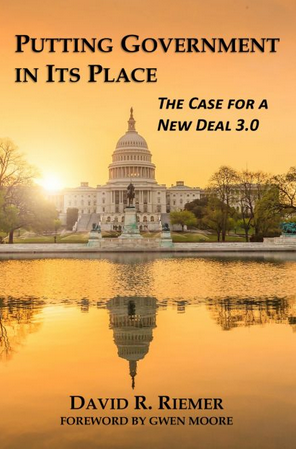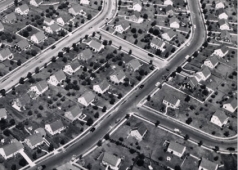The Old Normal
The current model of American government—what might be called the New Deal settlement—served the country reasonably well during the first three decades after World War II. Today, however, the fissures and flaws of today's model of government are woefully apparent.
A little history helps explain how we got in this fix.
The United States emerged from World War II as the world's dominant economy.
The policies of the New Deal further strengthened the American economy. Between 1933 and 1937, FDR and the New Dealers put in place a new, extensive, national system of economic security and market regulation. During the the next 80 years, additional policies of the New Deal writ large, particularly the G.I. Bill and the interstate portion of the Interstate Highway System, strengthened America's economic dominance and allowed its economy to provide economic security and even prosperity to an expanding share of Americans, including black workers and their families.
Ironically, the very success of the New Deal “settlement” during its heyday from 1945 to 1965 helped to mask its shortcomings and contradictions.
- Since the post-war economy provided jobs for almost anyone who could set an alarm clock, get out of bed, and fog a mirror, there was little need to worry about long-term unemployment.
- Since wages were rising and income climbing, there was little need to supplement them.
- Since collective bargaining increasingly provided workers with good health insurance, there was reason to believe that the problem of the uninsured would gradually fade away—especially after Medicaid insured many of the poor and Medicare insured the elderly.
- Since most jobs required little education—and since young adults were flooding colleges and universities, and graduating in droves with no or little debt--there was little need to worry either about the results of K12 education or the cost of higher education.
- Since many African Americans who moved to northern cities were making rapid economic gains, it was easy--at least for white Americans--to downplay the rigid segregation that legally still ruled the south and ignore the racial discrimination that permeated employment, housing, and law enforcement in the north.
The U.S. appeared to be sitting pretty.
Ironically, the very triumph of America's post-war economy--bolstered by fairly recent New Deal economic security and market regulation policies, accelerated by the G.I. Bill, and strengthened by the city-to-city piece of the Interstate Highway program--hid the shortcomings and contradictions that lay embedded within the New Deal's four policy “clusters.”
It was only a matter of time before America hit a wall.
Or to use Don McLean's metaphor in the song "American Pie," it was only a matter of time before America arrived at "the day the music died."
The world's slow return to economic "normalcy" during the last decades of the 20th century--epitomized by China's economic rise, featuring robust international competition, and resulting in a domestic economy that trade and technology disrupt with ever-faster frequency--now compels us to open our eyes to the true nature of American government's design flaws.
The long list and serious nature of the nationwide problems that government could fix ...
- high levels of violence;
- daunting public health problems;
- a deteriorating infrastructure;
- widespread unemployment and poverty;
- tens of millions of individuals with no health insurance;
- tens of millions of children who finish school without a real education;
- appalling levels of racial disparity and racial injustice;
- gross inequalities of income and wealth;
- still-inadequate protections for the environment, workers, consumers, and investors; and
- a sub-performing market, hamstrung by subsidies that undermine its efficiency and subvert its capacity to maximize the nation's wealth.
...further impels us to try to understand what exactly how we should reform American government to bring about the necessary fix.
Only by facing up to the consequences of America's riskier position in the "new normal" of today's world's economy, and honestly assessing the nation's many and troubling flaws, can we create a better version of American government--a new design that truly puts government in its proper place as a strong instrument for ever-expanding freedom.



